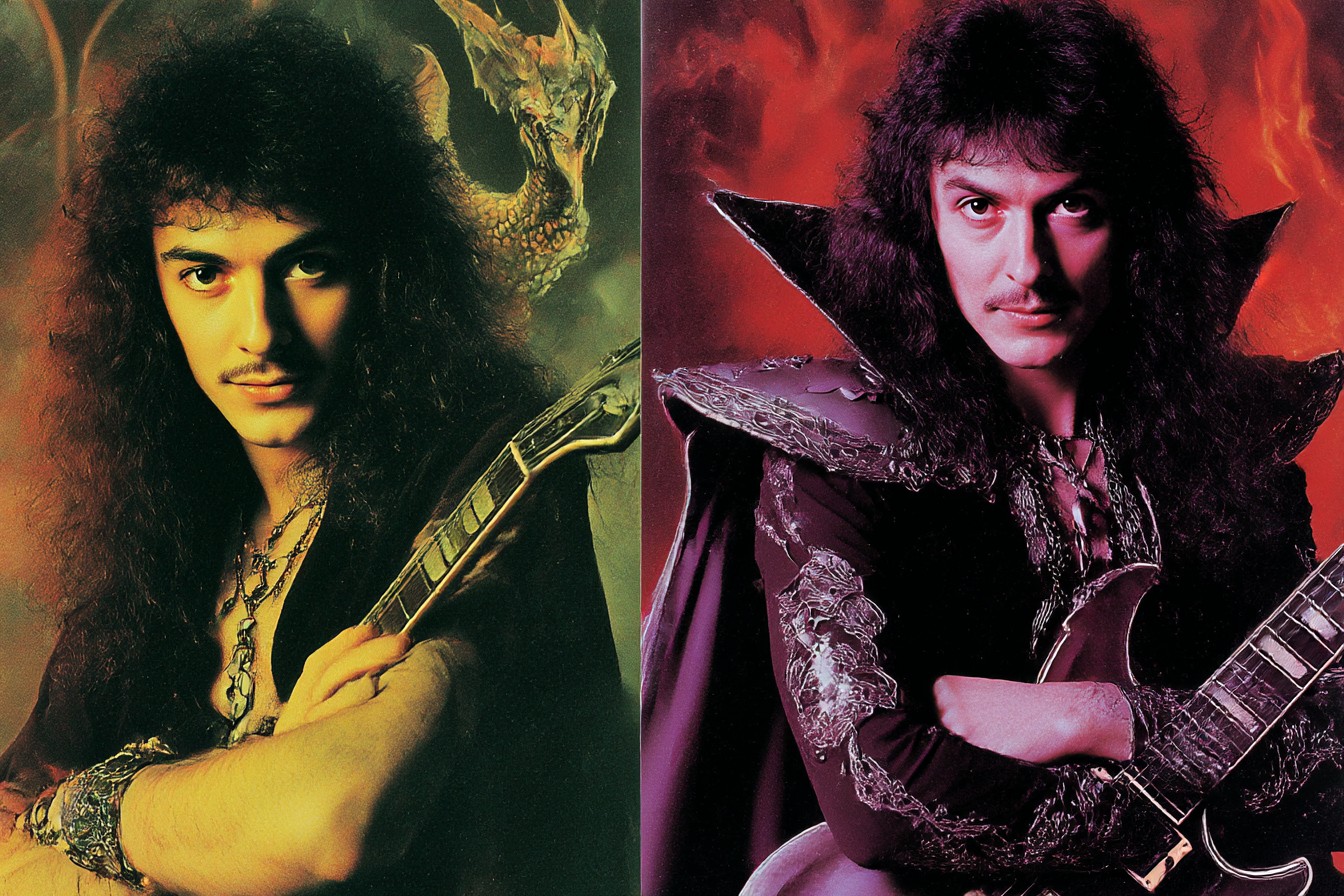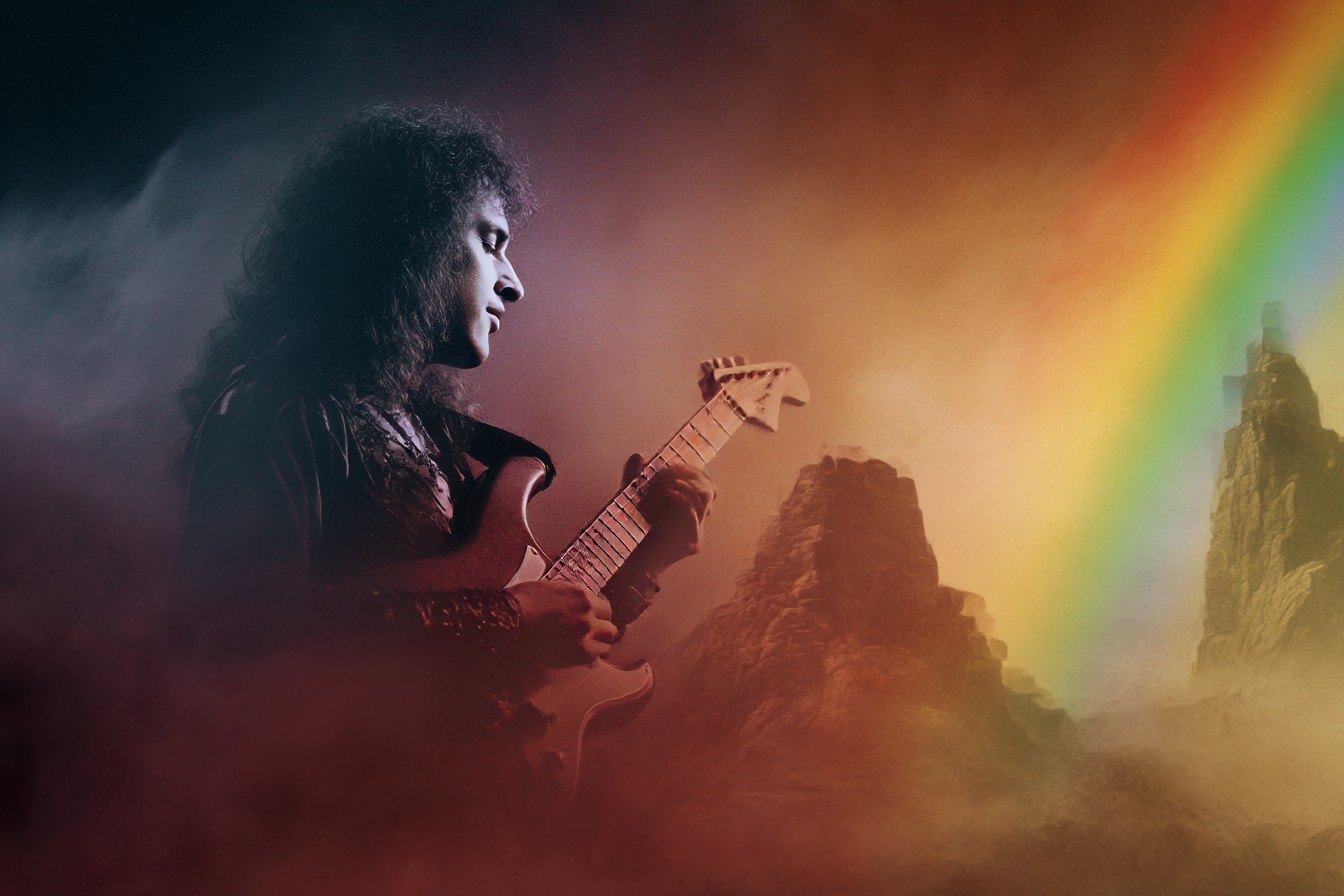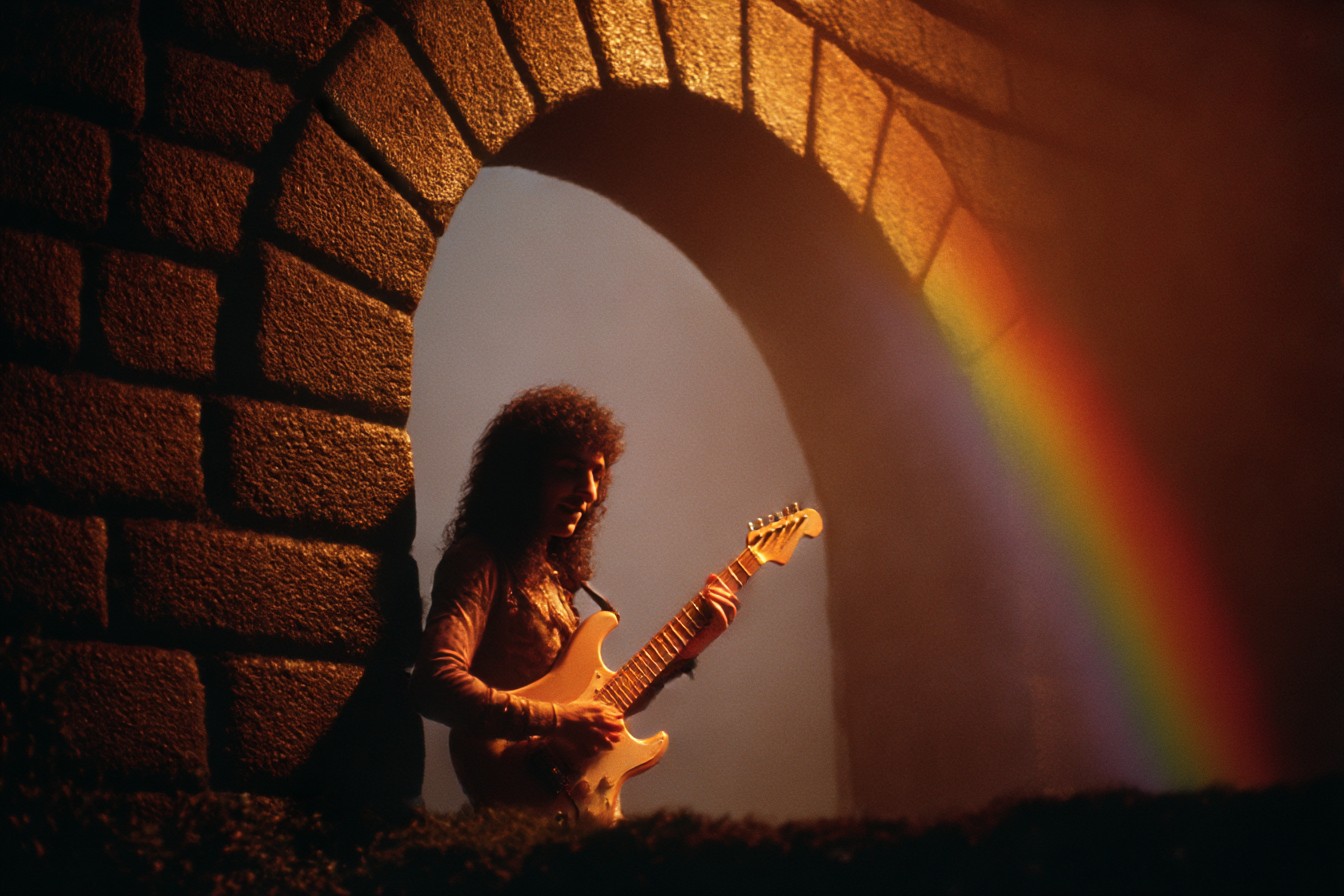The first time I heard Rainbow’s “Rising,” I was thirteen years old, sitting cross-legged on my older cousin David’s bedroom floor while he performed what I now recognize as a sacred ritual of musical initiation. David was seventeen, had hair down to his shoulder blades, and possessed what seemed to me the coolest collection of records in the known universe. He’d recently taken it upon himself to correct what he called my “catastrophically deficient musical education” after discovering, to his horror, that I’d been wasting my allowance on whatever garbage Casey Kasem was pushing on American Top 40.
“This,” David said with the gravity of someone about to reveal profound cosmic truths, “is what happens when one of rock’s greatest guitarists meets the greatest voice heavy music will ever know.”
He lowered the needle onto “Tarot Woman,” and I watched his expression shift from solemn instruction to something approaching religious ecstasy as Cozy Powell’s drums announced themselves and Ritchie Blackmore’s guitar emerged from Tony Carey’s swirling synthesizer intro. But it was when Ronnie James Dio’s voice entered—that impossibly powerful, almost operatic instrument—that I understood I was experiencing something transformative. By the time the side one closer “Stargazer” had finished its epic journey, complete with actual orchestral backing, I had been converted. Not just to Rainbow, but to the entire concept of heavy music as something that could be mystical, fantastical, and transportive.
Released in 1976, “Rising” represents one of those perfect alchemical moments in rock history—when the right musicians find each other at exactly the right time, creating something greater than even their considerable individual talents might suggest. The album marked Rainbow’s second release, but it was the first to feature what many consider the band’s definitive lineup: Blackmore on guitar, Dio on vocals, Powell on drums, Jimmy Bain on bass, and Tony Carey on keyboards.
The partnership between Blackmore and Dio sits at the heart of what makes “Rising” so magical. Here were two musical forces that should have been incompatible on paper—Blackmore, the moody, classically influenced guitar virtuoso from Deep Purple, known for his technical brilliance and mercurial temperament; and Dio, the golden-voiced former doo-wop singer turned heavy rock vocalist with a penchant for fantasy lyrics and theatrical delivery. Yet somehow, these seemingly disparate elements combined to create something that would help define the template for what we now recognize as “classic” heavy metal.
Blackmore had formed Rainbow (initially called Ritchie Blackmore’s Rainbow) after growing frustrated with Deep Purple’s increasingly funk and soul-influenced direction. He wanted to explore a heavier, more medieval-tinged sound that drew from his classical influences while maintaining rock’s primal energy. In Dio, whom he’d discovered fronting the band Elf, he found the perfect vocal vessel for these ambitions—a singer whose technical ability and dramatic delivery could match the grandeur of his compositional vision.
“Rising” wastes no time establishing its mystical credentials. “Tarot Woman” opens with that now-iconic synthesizer passage that sounds like wizard music from some alternate medieval dimension before Blackmore’s guitar cuts through with crystalline precision. It’s worth pausing here to appreciate just how revolutionary Blackmore’s guitar work was in this context. Unlike many of his contemporaries who were pushing toward ever-greater levels of distortion and aggression, Blackmore maintained this remarkable clarity in his tone—every note distinct, every phrase precisely articulated. It’s virtuosic playing that never descends into mere showmanship, always serving the song while simultaneously elevating it.
And then there’s Dio. His performance on “Tarot Woman” immediately announces a vocalist operating on a different plane than most rock singers of the era. The control, the power, the almost supernatural ability to shift from intimate verses to soaring choruses—it’s listening to a master at the height of his powers. The lyrics establish the album’s fixation with mysticism and the occult, something that would become a Dio trademark throughout his career and influence countless metal bands that followed.
“Run with the Wolf” follows, showcasing the rhythm section of Powell and Bain. Powell, in particular, deserves special recognition for his contribution to “Rising.” His drumming combines technical prowess with an almost physical sense of drama—listen to how he builds tension throughout “Stargazer” or drives “A Light in the Black” with those propulsive double bass patterns that would become a heavy metal staple. This wasn’t just keeping time; this was percussion as narrative force.
The album’s centerpiece, however, is undoubtedly “Stargazer”—a song so monumental in scope and execution that it practically created the template for epic metal. Opening with Powell’s thunderous drum pattern (a motif so distinct that metal fans can recognize the song from those first few seconds alone), it unfolds over eight and a half minutes of crescendoing drama. The addition of the Munich Philharmonic Orchestra could have been disastrous in less skilled hands—how many rock bands have been buried under well-intentioned but poorly integrated orchestral arrangements? But here, the orchestra becomes an organic extension of the band, enhancing the song’s inherent grandeur rather than competing with it.
Blackmore’s solo on “Stargazer” deserves special mention—a masterclass in tasteful virtuosity that builds from delicate, almost questioning phrases to soaring, emotional peaks. It’s the perfect example of why Blackmore stands apart from many of his shred-oriented followers; every note has purpose, every bend and run communicating something beyond mere technical facility.
And Dio’s performance? Simply transcendent. The way he navigates the song’s shifting dynamics, from the narrative verses to that towering, yearning chorus, showcases a vocalist of extraordinary range—not just in terms of octaves (though those high notes remain astonishing), but in emotional expressiveness. This wasn’t just a heavy rock singer; this was a storyteller using his voice as a dramatist uses the stage.
The album closes with “A Light in the Black,” a high-velocity showcase for the band’s technical capabilities that features some of Blackmore’s most dazzling fretwork and Powell’s most aggressive drumming. It’s the perfect conclusion—a reminder that for all the mystical atmospherics and compositional sophistication, Rainbow could still deliver pure, adrenaline-pumping heavy rock when they wanted to.
What makes “Rising” particularly significant in metal’s evolution was how it expanded the genre’s thematic and musical vocabulary. Prior to this, heavy rock had largely been concerned with blues-derived riffing, straightforward lyrics about love/sex/partying, or vague occultism in the Black Sabbath mode. Rainbow offered something different—a more European sensibility that drew from classical music, medieval and Renaissance themes, and fantasy literature. The album’s cover art by fantasy artist Ken Kelly (who would later create iconic sleeves for KISS and Manowar) perfectly captured this sensibility—a sorcerer-like figure raising a rainbow from the ocean through apparent magical will.
This approach would prove enormously influential on what would become power metal, particularly in Europe. Bands like Helloween, Blind Guardian, and Stratovarius owe an incalculable debt to the template established on “Rising”—the combination of classical influences, fantasy themes, theatrical vocals, and technical precision. Even more extreme subgenres like black metal would eventually incorporate elements of this approach, particularly in the more symphonic and folk-influenced variants.
The Blackmore-Dio partnership would only produce one more studio album together—1978’s excellent but slightly less cohesive “Long Live Rock ‘n’ Roll”—before Dio departed for Black Sabbath (where he would help revitalize that band with “Heaven and Hell”) and eventually his own eponymous group. Blackmore would continue with Rainbow through multiple lineup changes, gradually steering the band toward a more commercial hard rock sound with vocalists like Graham Bonnet and Joe Lynn Turner.
But neither would ever quite recapture the magic of “Rising,” that perfect moment when their unique talents aligned to create something that transcended their individual brilliance. It was lightning in a bottle—a brief but incandescent creative partnership that expanded the possibilities of what heavy music could be.
I’ve owned “Rising” in virtually every format available—the original vinyl that I eventually wore out in college, the first CD pressing that sounded thin and lifeless compared to the analog warmth of the record, the remastered CD that improved things considerably, and most recently, a 180-gram vinyl reissue that sits in the “special collection” section of my admittedly obsessive record storage system. Each version has accompanied me through different phases of my life, but the effect remains the same—that sense of transportation to a world of mystical grandeur that thirteen-year-old me experienced on my cousin’s bedroom floor.
Speaking of David, he’s now a 58-year-old accountant with a sensible haircut who listens primarily to jazz and classical music. But a few years ago, at a family reunion, I caught him air-drumming to “Stargazer” when it came on the playlist I’d put together. Some initiations leave permanent marks on the soul.
In 2010, I had the bittersweet opportunity to interview Dio just months before his untimely death from stomach cancer. When I mentioned “Rising” and its impact on me, his eyes lit up with genuine warmth.
“That was a special time,” he said, his speaking voice surprisingly gentle compared to his powerful singing. “Ritchie and I pushed each other to places we probably wouldn’t have gone alone. He made me think about vocals differently—more like a classical instrument. And I think maybe I helped him see that all that brilliant guitar work could tell stories, not just impress other musicians.”
That, perhaps, is the essence of why “Rising” endures—it’s technically impressive music that never loses sight of storytelling and emotional impact. It’s virtuosic but not self-indulgent, fantastical but emotionally authentic, heavy but never sacrificing melody or dynamics to mere aggression. It’s the sound of two musical forces that should have been incompatible finding unexpected harmony and, in the process, expanding the very definition of what heavy music could achieve.
Nearly fifty years later, “Rising” still sounds remarkably fresh—its production warm and organic in an era of increasingly digital sterility, its compositions still surprising in their ambition and execution. It stands as testament to a time when heavy metal was still defining itself, still discovering its potential to be not just aggressive or shocking, but genuinely magical—capable of transporting listeners to realms of imagination as effectively as any fantasy novel or film.
In my decades of writing about music, I’ve seen countless trends come and go, watched subgenres splinter into increasingly specialized niches, and observed the ever-accelerating cycle of influence and revival. Through it all, certain albums remain fixed points—works of such perfect execution and vision that they transcend their era to become timeless. “Rising” is undoubtedly one of these—a moment when heavy metal shed its earthly constraints and learned it could soar among the stars, guided by a wizard’s guitar and the voice of a storyteller who seemed to have lived a thousand lives.
And somewhere, in bedrooms and basements around the world, older siblings and cousins are still performing that sacred ritual of initiation—lowering the needle on “Tarot Woman” and watching as another generation discovers the mystical possibilities of heavy music through Ritchie Blackmore, Ronnie James Dio, and the perfect partnership that produced “Rising.”





Leave a Reply